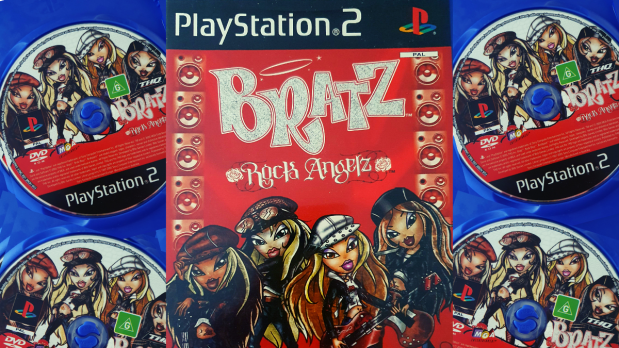‘Bratz Rock Angelz‘ is a single-player, adventure-style video game that was released in 2005, developed by Blitz Games. Available on PlayStation 2 (PS2), Nintendo GameCube and Microsoft (PC), ‘Bratz Rock Angelz’ allows players to embark on a passion for fashion, playing as each Bratz doll – Yasmin, Jade, Sasha and Cloe – to create their own magazine, form a band and travel the world.
To deep-dive into such an iconic video game, my analytical framework for ‘Bratz Rock Angelz’ would include:
– technology
– narrative
– fandom
Analysing based on the technology of ‘Bratz Rock Angelz’ would be effective. Released in 2005, the graphics are simple and now outdated… as are the consoles the game was available on. In this regard, the game can be labelled as “forgotten”, because as technology and consoles have advanced, ‘Bratz Rock Angelz’ has not received an anniversary edition upgrade, nor has it become available on modern platforms such as mobile, PS4, Nintendo Switch or even any XBOX generation.
Lawrence Stone believes that narrative is the “organisation of material in a chronologically sequential order and the focusing of the content into a single coherent story, albeit with subplots.”
‘Bratz Rock Angelz’’s narrative, inspired by the animated ‘Bratz’ movie of the same name, is multi-dimensional and layered, open to a deep analysis. Whilst mini tasks are set for players – “subplots” -the overarching narrative encompasses the Bratz’s passion for fashion, music, beauty, and travel within the gameplayer. However, players can also roam free in the Bratz world.
Mary Fuller and Henry Jenkins discuss this concept in “Nintendo and New World Travel Writing” stating that video games and travel diaries share similarities, where although challenges are designed to be completed, much of the fun in video games can be found in the storytelling and progression between levels that allow us to “immerse ourselves in the spectacle of the video game”.

Narrative being included in the analytical framework would allow this concept to be expanded upon in the context of ‘Bratz Rock Angelz’, which is particularly valuable given it is a single-player game.
Fandom is also a crucial inclusion of the analytical framework of ‘Bratz Rock Angelz’ as acknowledging the broader fan community ensures a variety of interpretations and opinions are included, as mentioned in our latest BCM215 lecture. Analysing the Bratz fandom also gives opportunity for paratextual analysis as ‘Bratz’ encompasses a variety of media and merchandise, and it would be interesting to explore the ways in which fans respond to them, plus the ways in which this influences the way ‘Bratz Rock Angelz’ is engaged with as a video game. YouTube and Twitch are great platforms to utilise for this, as fans stream while playing the game and influencers even created the Bratz makeover trend!
Maybe ‘Bratz Rock Angelz’ isn’t so “forgotten” after all…
Feature Image: photographed and created by Natalie Hannan

Reblogged this on Game Cultures.